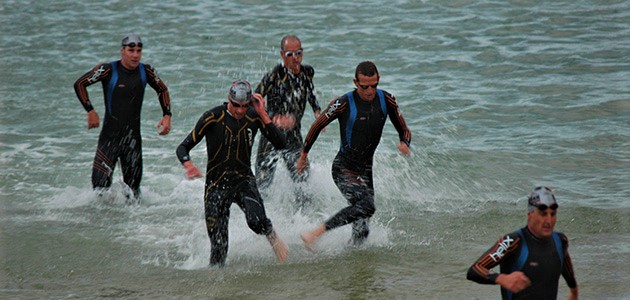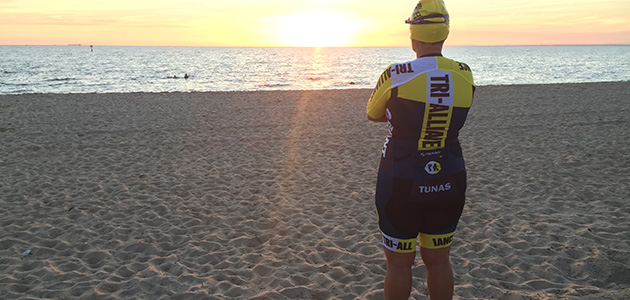Open Water Swimming – Tips for training & racing
Open water swimming can be daunting, even for a seasoned competitor, but as the weather starts to warm up over spring and summer you know it’s time to get out in the bay and practise your open water swimming. Beginners who join Tri Alliance have the benefit of training in groups with an experienced coach (in both the pool and the ocean). But check out our tips to help you gain the confidence you need in the open water.
So here are some great tips to help you get started:

Training
Safety
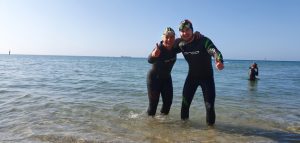 Never, swim alone! Know your skill level and don’t go too far out of your depth.
Never, swim alone! Know your skill level and don’t go too far out of your depth.- Learn to feel comfortable to float on your back. If you get into trouble, you can simply flip onto your back with your feet to the shore (this stops the waves hitting your face). Wait until you catch your breath and feel comfortable enough to make your way back to shore.
Entering the water
- Practise entering the water. You want to run off the beach into the water with knees high and legs kicking outwards to avoid resistance from the water on your way in. When your legs start to resist against the water (usually mid thigh – no deeper!), you then need to start ‘porpoising’.
- If the water is chopping, try to time your porpoising so you dive under the white ‘broken’ waves and swim over rolling green waves.
- Use high elbows when you begin to swim to get you over the waves or rough water that forms close to the shore.
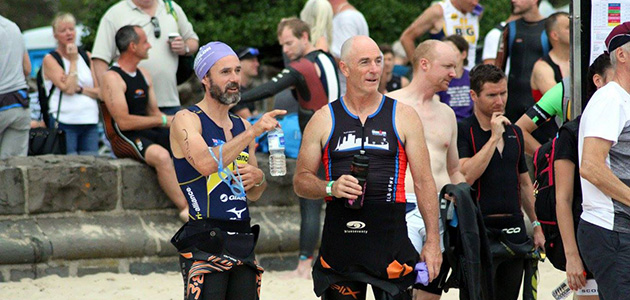
Breathing
- You want to practise and learn to breathe both sides. This will assist in races where you might be swimming in different directions and waves could be coming from either side.
- So if it is chopping make sure you breathe away from the waves!
Sighting and navigation
- Sighting is one of the most important parts of open water swimming. If you are not good at sighting, then you will find yourself swimming a lot further than you have to!
- So practice sighting. Look up every 5-10 strokes to make sure you’re going in the right direction.
- Sighting should not slow you down or break your stroke. Simply lift your head so your eyes just come above the water. Have a quick glance to make sure you are on the right track and then turn your head to its normal position.
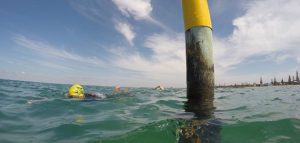
- You don’t want to hold your head up for too long as doing so will drop your lower body in the water, which creates unnecessary and will therefore slow you down.
Navigating around buoys
- There are a few things to remember when coming to a buoy. You may not want to head straight for it if you are in a pack. Swimmers tend to bottle neck trying to get around the buoy as they try and turn around it as close as possible. Save yourself the trouble and swim a little wider. This will stop you from getting stuck in the traffic and having to slow your stroke down.
- When you approach, make sure you have the buoy in your sight. As you approach pull your inside arm (arm closest to the buoy) under your body as your round the buoy. This will get your around faster.
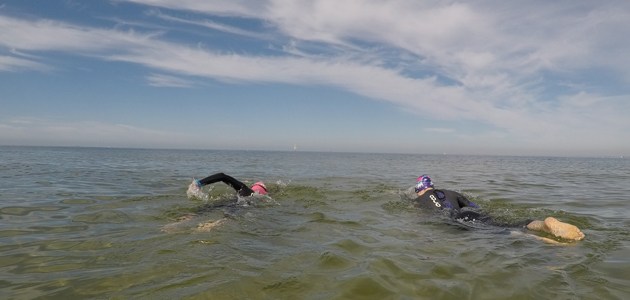
Drafting
- In the swim – drafting is legal! And you can save a lot of energy (and time) by swimming behind someone who is a little faster than you.
- Once you are comfortable in the swim, try and find someone in front or alongside you who is swimming a little faster. Surge to catch them if they are in front, or keep swimming and wait for them to pass you . Once they do, swim as close to them as possible – literally nearly touching their feet, or slightly to their left or right. You will gain an advantage by getting ‘pulled’ along in their wake.
- You can practise this technique in the pool with your training partner/s or squad and notice how much easier it is to swim.
Exiting the water
- The biggest mistake competitors make is trying to stand up to early. You only want to stop swimming and stand up when your hands touch the sand as you stroke. This means the water will be about waist height.
- Stand up quickly and porpoise in until you can easily run above the water. Do not try and start running if the water is still above mid thigh.
To improve your open water swimming, you want to train in the bay at least once a week during the warmer weather). This will allow you to train in different conditions, gain confidence and practise the skills taught. Tri Alliance holds sessions at Elwood Lifesaving Club on Thursday evenings and Saturday Mornings from November – March each year. Join one of our beginner training programs to participate and learn more!
